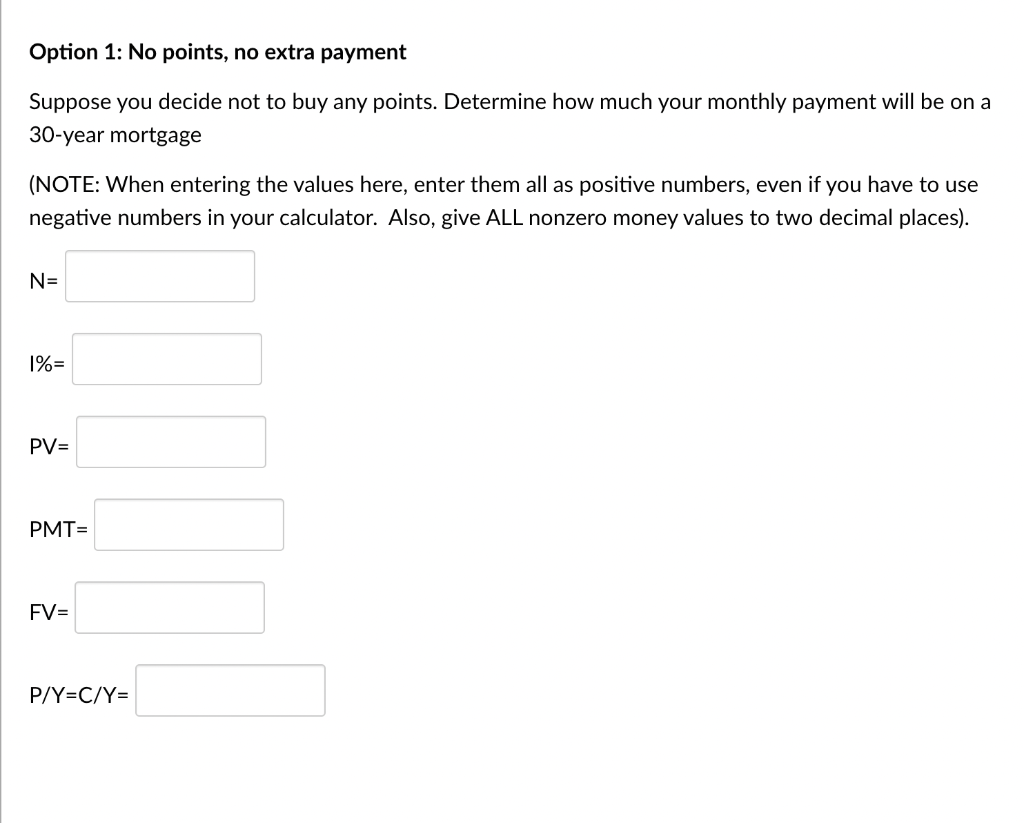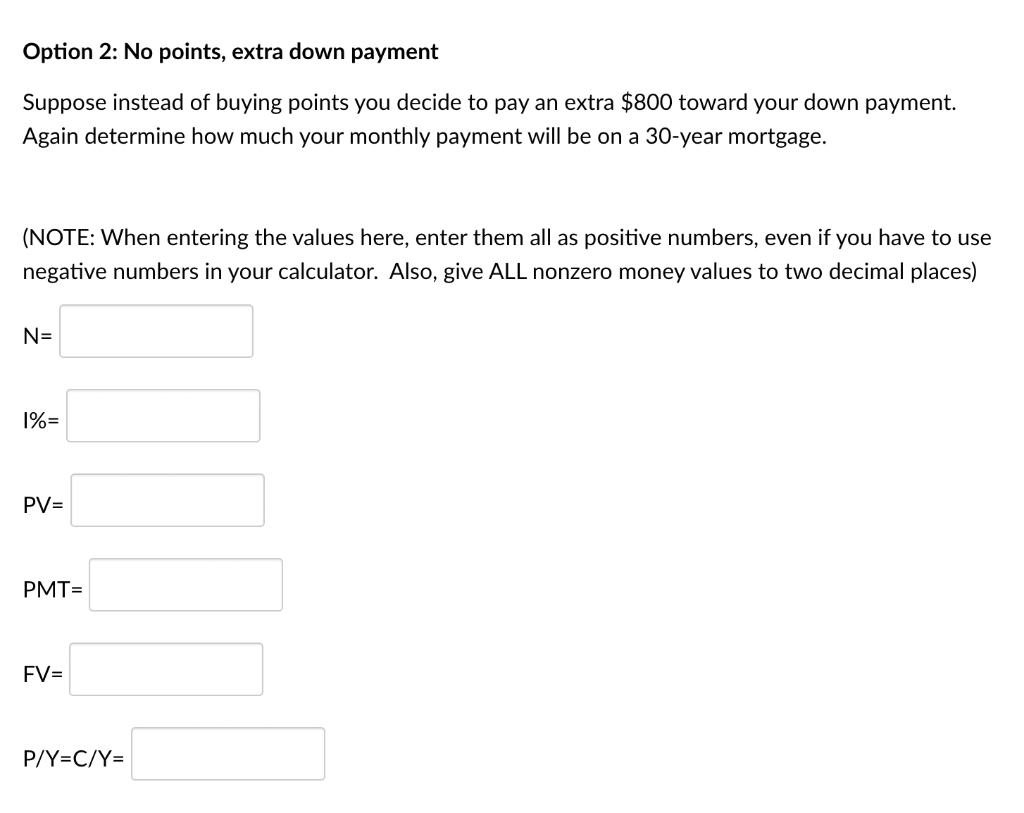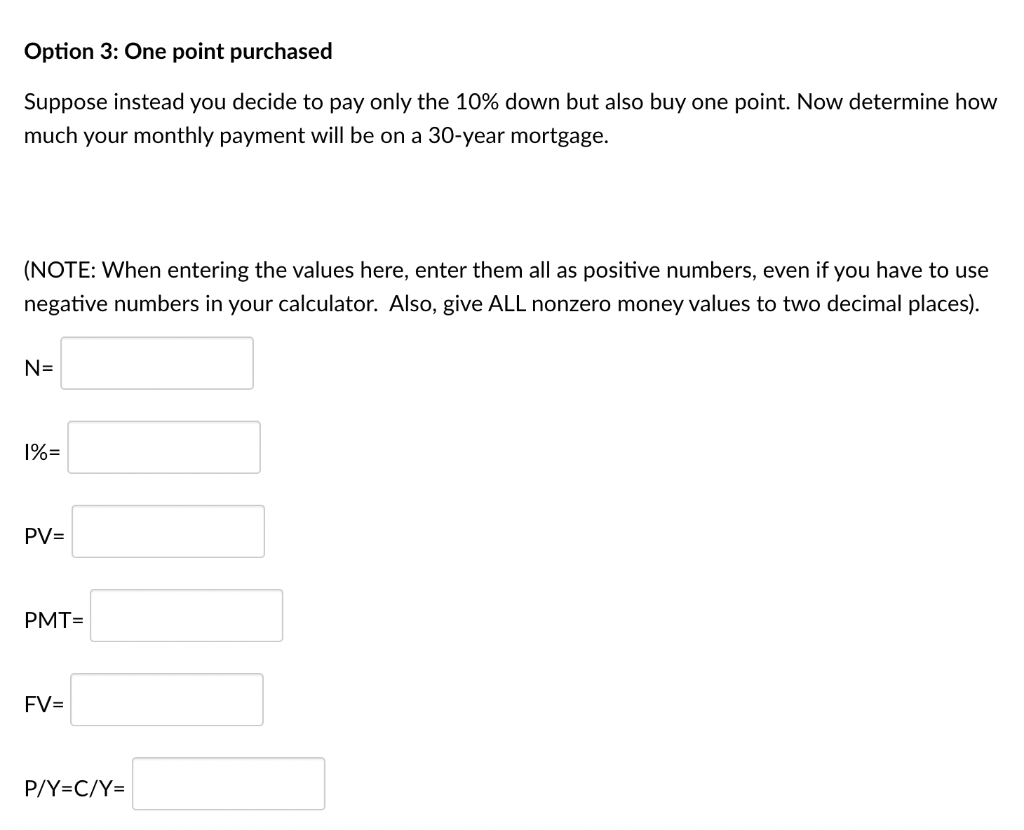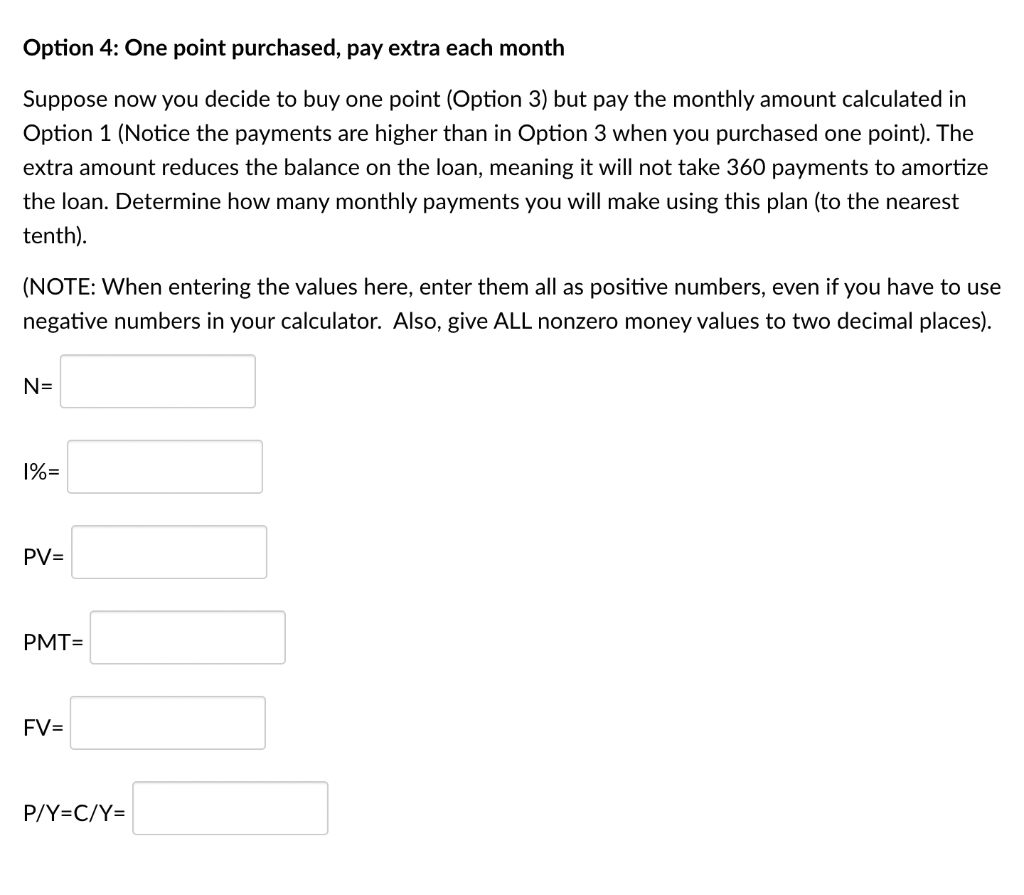








Background: Congratulations! You have just decided to buy a $200,000 house. It's time to consider the question of financing the mortgage. You have to put 10% as a down payment. This leaves $180,000 to borrow. In addition to your down payment, you have the option of purchasing "points". Closing costs (which are additional fees paid up front with the down payment) will be $7500 and the interest rate on the mortgage will be 4.5% per year compounded monthly. If you choose to pay points, the closing costs go up $800 for each point but your interest rate goes down 0.125% (NOTE: points are much more complicated than that, but we'll keep it simple for understanding). (ALSO NOTE: Give exact answers where possible; for all other answers, round appropriately). Option 1: No points, no extra payment Suppose you decide not to buy any points. Determine how much your monthly payment will be on a 30-year mortgage (NOTE: When entering the values here, enter them all as positive numbers, even if you have to use negative numbers in your calculator. Also, give ALL nonzero money values to two decimal places). N= = 1%= PV= PMT= FV= P/Y=C/Y= For Option I, determine the total amount you pay on the house (be sure to include your down payment and closing costs as well!). Option 2: No points, extra down payment Suppose instead of buying points you decide to pay an extra $800 toward your down payment. Again determine how much your monthly payment will be on a 30-year mortgage. (NOTE: When entering the values here, enter them all as positive numbers, even if you have to use negative numbers in your calculator. Also, give ALL nonzero money values to two decimal places) N= 1%= PV= PMT= FV= P/Y=C/Y= For Option 2, determine the total amount you pay on the house (be sure to include your down payment and closing costs as well!). Option 3: One point purchased Suppose instead you decide to pay only the 10% down but also buy one point. Now determine how much your monthly payment will be on a 30-year mortgage. (NOTE: When entering the values here, enter them all as positive numbers, even if you have to use negative numbers in your calculator. Also, give ALL nonzero money values to two decimal places). N= N= 1%= PV= PMT= FV= P/Y=C/Y= For Option 3, determine the total amount you pay on the house (be sure to include your down payment and closing costs as well!). Option 4: One point purchased, pay extra each month Suppose now you decide to buy one point (Option 3) but pay the monthly amount calculated in Option 1 (Notice the payments are higher than in Option 3 when you purchased one point). The extra amount reduces the balance on the loan, meaning it will not take 360 payments to amortize the loan. Determine how many monthly payments you will make using this plan (to the nearest tenth). (NOTE: When entering the values here, enter them all as positive numbers, even if you have to use negative numbers in your calculator. Also, give ALL nonzero money values to two decimal places). N= 1%= PV= PMT= FV= P/Y=C/Y= For Option 4, determine the total amount you pay on the house (be sure to include your down payment and closing costs as well!). Notice how this answer compares to the others! Background: Congratulations! You have just decided to buy a $200,000 house. It's time to consider the question of financing the mortgage. You have to put 10% as a down payment. This leaves $180,000 to borrow. In addition to your down payment, you have the option of purchasing "points". Closing costs (which are additional fees paid up front with the down payment) will be $7500 and the interest rate on the mortgage will be 4.5% per year compounded monthly. If you choose to pay points, the closing costs go up $800 for each point but your interest rate goes down 0.125% (NOTE: points are much more complicated than that, but we'll keep it simple for understanding). (ALSO NOTE: Give exact answers where possible; for all other answers, round appropriately). Option 1: No points, no extra payment Suppose you decide not to buy any points. Determine how much your monthly payment will be on a 30-year mortgage (NOTE: When entering the values here, enter them all as positive numbers, even if you have to use negative numbers in your calculator. Also, give ALL nonzero money values to two decimal places). N= = 1%= PV= PMT= FV= P/Y=C/Y= For Option I, determine the total amount you pay on the house (be sure to include your down payment and closing costs as well!). Option 2: No points, extra down payment Suppose instead of buying points you decide to pay an extra $800 toward your down payment. Again determine how much your monthly payment will be on a 30-year mortgage. (NOTE: When entering the values here, enter them all as positive numbers, even if you have to use negative numbers in your calculator. Also, give ALL nonzero money values to two decimal places) N= 1%= PV= PMT= FV= P/Y=C/Y= For Option 2, determine the total amount you pay on the house (be sure to include your down payment and closing costs as well!). Option 3: One point purchased Suppose instead you decide to pay only the 10% down but also buy one point. Now determine how much your monthly payment will be on a 30-year mortgage. (NOTE: When entering the values here, enter them all as positive numbers, even if you have to use negative numbers in your calculator. Also, give ALL nonzero money values to two decimal places). N= N= 1%= PV= PMT= FV= P/Y=C/Y= For Option 3, determine the total amount you pay on the house (be sure to include your down payment and closing costs as well!). Option 4: One point purchased, pay extra each month Suppose now you decide to buy one point (Option 3) but pay the monthly amount calculated in Option 1 (Notice the payments are higher than in Option 3 when you purchased one point). The extra amount reduces the balance on the loan, meaning it will not take 360 payments to amortize the loan. Determine how many monthly payments you will make using this plan (to the nearest tenth). (NOTE: When entering the values here, enter them all as positive numbers, even if you have to use negative numbers in your calculator. Also, give ALL nonzero money values to two decimal places). N= 1%= PV= PMT= FV= P/Y=C/Y= For Option 4, determine the total amount you pay on the house (be sure to include your down payment and closing costs as well!). Notice how this answer compares to the others















